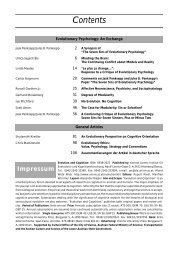Contents - Konrad Lorenz Institute
Contents - Konrad Lorenz Institute
Contents - Konrad Lorenz Institute
Create successful ePaper yourself
Turn your PDF publications into a flip-book with our unique Google optimized e-Paper software.
Theresa S. S. Schilhab<br />
What supports this contention First, explicit<br />
learning involves a significant reduction of parameters<br />
in mental representation, which I refer to as<br />
“condensation of reality”. But research paradigms<br />
demonstrating implicit learning are typically complex<br />
in the sense of concealing a huge number of parameters<br />
essential to solving the task in a large web<br />
of information, which makes explicit strategies impossible<br />
to employ. For instance VINTER/PERRUCHET<br />
(2000) reported on implicit drawing behaviour in<br />
children aged 4–10 years. To confront criticism related<br />
to explicit knowledge criteria, the researchers<br />
developed a paradigm named a “neutral parameter<br />
procedure” and deliberately diverted participant’s<br />
attention to test clues to avoid the use of explicit<br />
knowledge obtained during the test procedure. Experimenters<br />
specifically attempted to blur conscious<br />
awareness of connections between any two variables.<br />
Still, by responding appropriately, the subjects<br />
seemed capable of catching contingencies between<br />
many variables, while being perfectly<br />
unaware of doing so.<br />
The same applies to the artificial grammar test.<br />
When subjects were asked to explain how they discriminated<br />
between grammatical and nongrammatical<br />
sentences, they either denied consciously following<br />
any rule or they gave reasons irrelevant to<br />
solving the task.<br />
Similar results are obtained with computer simulations<br />
of sugar fabrication (BERRY/DIENES 1993).<br />
Here people were asked to attain a specific amount<br />
of sugar (in tons) by varying different parameters<br />
interconnected by a pattern created by the experimenters,<br />
but opaque to the subjects. After a number<br />
of trials they succeeded. When subjects were<br />
subsequently asked to verbalise which rules they<br />
applied to obtain the outcome and these rules were<br />
followed by novices the end result was strikingly<br />
poor. Obviously, the articulated rules do not mirror<br />
the rules actually applied. Somehow knowledge residual<br />
to the volunteered information remains to<br />
be revealed. In support of this are studies within<br />
the sugar production paradigm that focus on how<br />
to make explicit what could originally be learned<br />
only implicitly. By pinpointing the connections<br />
between dependent variables or reducing the number<br />
of parameters responsible for a successful outcome,<br />
subjects suddenly gained insight they could<br />
subsequently verbalise. Evidently, to switch from<br />
implicit to explicit modes of learning involves<br />
both accentuating elements that determine the<br />
task and reduction of the number of elements<br />
(DIENES 1993).<br />
Implicit Learning and the<br />
Evolutionary Stance<br />
The premise that implicit learning is more congruent<br />
with reality than explicit learning as regards representation<br />
can be explained theoretically. From an<br />
evolutionary perspective, for social organism like humans<br />
the physical as well at the social environment<br />
is enmeshed in information of potential importance<br />
to survival (BYRNE 1995). The mere fact of balancing<br />
the surface can be realised only by taking in a large<br />
amount of information (COTTERILL 2002). Likewise,<br />
navigation in the social world, originally adapted to<br />
interpret tribal relations and coalitions in prehistoric<br />
society (WRANGHAM et al. 1994), now entails coping<br />
with a multitude of modern social conventions and<br />
regulations (COLLINS 2001) such as, for example, table<br />
manners and traffic rules. Information important<br />
to survival does not come about in isolated incidents,<br />
but relates to cues in the environment.<br />
Environmental complexity clearly explains why<br />
implicit learning is less detached from context<br />
with respect to condensating reality. But the question<br />
remains, does this hold for (a) detachments<br />
caused by simplification and (b) does not any interpretation<br />
involve detachments irrespective of<br />
whether it results in simplifcations or distortions<br />
of the original source of information Of course<br />
the answer is affirmative. Over time, natural selection<br />
favoured perception and learning of certain<br />
stimuli and environmental contingencies, which<br />
naturally entails perspective-taking followed by<br />
simplification or distortion of information.<br />
Though the difference in contextual detachment<br />
between implicit and explicit learning is a matter<br />
of degree, the consequences are significant. Explicit<br />
learning, however, emerged as an expansion<br />
to an already well functioning system (see also EN-<br />
NEN 2002). The contribution of the new system was<br />
primarily to control learning capabilities, including<br />
the deliberate selection of information to be<br />
learned and the intentional application of the<br />
knowledge obtained (GIBSON/INGOLD 1993).<br />
Though the explicit learning system evolved to<br />
profit from intentionel manipulation of information,<br />
it emerged to increase survival.<br />
To understand in what respect implicit learning<br />
is closer to context we must return to evolutionary<br />
considerations. Implicit learning registers a greater<br />
number of variables, as well as their intricate pattern,<br />
‘invisible’ to the explicit capacity, because it<br />
seems appropriate to survival. But why This appears<br />
due to that implicit learning was developed<br />
Evolution and Cognition ❘ 174 ❘ 2003, Vol. 9, No. 2








